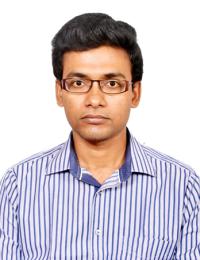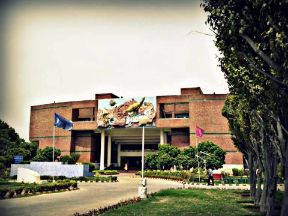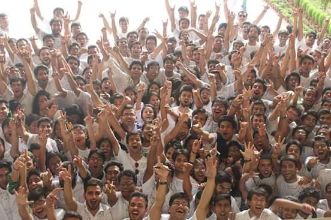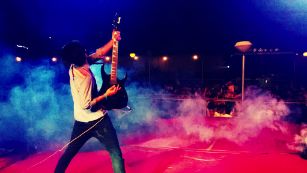
Office Address
Room No.: PC-06, Department of Civil Engineering, NSUT (West Campus), Jaffarpur, New Delhi- 110073
BIOSKETCH
Dr. Arghya Ghosh is working as Assistant Professor in the Department of Civil Engineering, Netaji Subhas University of Technology, New Delhi. Dr. Ghosh has completed his Bachelor of Civil Engineering and Master of Engineering in Civil Engineering with the specialization of Structural Engineering from Jadavpur University, Kolkata in 2011 and 2013 respectively. He has achieved his Ph.D. (Engineering) degree also from Jadavpur University in 2019. In his Ph.D. tenure, he was a full time TEQIP-II research scholar. Dr. Ghosh is very much interested in teaching and research. He has more than 10 years of teaching (as guest/visiting/regular faculty) and research experiences. He has published articles in various international journals, conferences and book chapters.
Areas of Interest:
- Failure of Laminated Composite Plates and Shells
- Finite Element Method-Geometric Nonlinearity
- Stability of Civil Engineering Structures
- Static and Dynamic Analyses of Advanced Structural Materials.
- Teaching Experience
-
- Guest / Visiting Faculty, Department of Civil Engineering, Jadavpur University, Kolkata (January 2014 - December 2018).
- Assistant Professor, Department of Civil Engineering, Techno India University, Kolkata (December 2018 - December 2021).
- Assistant Professor, Department of Civil Engineering, Netaji Subhas University of Technology (December 2021- till date).
- Subjects Taught / Teaching
-
B.Tech. Courses: Advanced Structural Analysis (Theory & Practical), Advance Structural Design, Design of Steel Structures, Structural Dynamics, Architectural Structures - II, III & IV.
M.Tech. / Ph.D. Courses: Finite Element Method, Structural Dynamics, Theory of Plates and Shells, Advanced Structural Analysis (Practical).
- International Journal Publications - 16 (as on April 2025)
-
- D. Mawai, A. Ghosh and D. Chakravorty, On Nonlinear Performance of Composite Trapezoidal Plates Based on Failure Mechanics and Reusability, Mechanics of Advanced Materials and Structures, 2025, SCIE, (IF: 3.6). https://doi.org/10.1080/15376494.2025.2492306 (Online Published)
- D. Chatterjee, A. Ghosh and D. Chakravorty, Application of FEM in Nonlinear Progressive Failure of Composite Skew Plates with Practical Non-Uniform Edge Conditions, Structural Engineering and Mechanics, 2024, Vol. 90(3), pp. 287-299, SCIE, (IF: 2.2). https://doi.org/10.12989/sem.2024.90.3.287
- D. Chatterjee, A. Ghosh and D. Chakravorty, Progressive Failure Prediction of Laminated Composite Thin Skew Plates Under Transverse Loading Using Nonlinear Strains, The Journal of Strain Analysis for Engineering Design, 2024, Vol. 59(5), pp. 337-350, SCI, (IF: 1.8). https://doi.org/10.1177/03093247241240821
- D. Chatterjee, A. Ghosh and D. Chakravorty, First-Ply Failure Behaviour of Laminated Composite Skew Plates of Various Edge Conditions, Mechanics of Composite Materials, 2021, Vol. 57(5), pp. 699-716, SCIE, (IF:1.5). https://doi.org/10.1007/s11029-021-09989-4
- D. Chatterjee, A. Ghosh and D. Chakravorty, Finite Element Prediction of First-Ply Failure Loads of Composite Thin Skewed Hypar Shells Using Nonlinear Strains, Thin-Walled Structures, 2021, Vol. 167(108159), pp. 1-13, SCI, (IF: 5.7). https://doi.org/10.1016/j.tws.2021.108159
- D. Chatterjee, A. Ghosh and D. Chakravorty, Nonlinear First Ply Failure Study of Laminated Composite Skew Plates, Materials Today: Proceedings, 2021, Vol. 45(P6), pp. 4925-4930, SCOPUS. https://doi.org/10.1016/j.matpr.2021.01.370
- R. Kumar, D. Chatterjee, A. Ghosh and D. Chakravorty, First Ply Failure Behaviour of Laminated Composite Skew Plate Under Concentrated Load, International Journal of Research in Advent Technology, 2020, Vol. 8(6), pp. 28-33, Google Scholar. https://doi.org/10.32622/ijrat.86202004
- A. Ghosh and D. Chakravorty, FEM Analysis of Progressive Failure for Composite Hypar Shells, Strength of Materials, 2020, Vol. 52(4), pp. 507-520, SCIE, (IF: 0.7). https://doi.org/10.1007/s11223-020-00202-w
- A. Ghosh and D. Chakravorty, Application of FEM on First Ply Failure of Composite Hypar Shells With Various Edge Conditions, Steel and Composite Structures, 2019, Vol. 32(4), pp. 423-441, SCIE, (IF: 4.0). https://doi.org/10.12989/scs.2019.32.4.423
- A. Ghosh and D. Chakravorty, Nonlinear First Ply Failure Analysis of Composite Skewed Hypar Shells Using FEM, Structural Engineering and Mechanics, 2018, Vol. 68(1), pp. 81-94, SCIE, (IF: 2.2). https://doi.org/10.12989/sem.2018.68.1.081
- A. Ghosh and D. Chakravorty, First Ply Failure Analysis of Laminated Composite Thin Hypar Shells Using Nonlinear Finite Element Approach, Thin-Walled Structures, 2018, Vol. 131, pp. 736-745, SCI, (IF: 5.7). https://doi.org/10.1016/j.tws.2018.07.046
- A. Ghosh and D. Chakravorty, First-Ply-Failure Performance of Composite Clamped Spherical Shells, Mechanics of Composite Materials, 2018, Vol. 54(2), pp. 191-206, SCIE. (IF:1.5). https://doi.org/10.1007/s11029-018-9731-y
- A. Ghosh and D. Chakravorty, Failure Analysis of Civil Engineering Composite Shell Roofs, Procedia Engineering, 2017, Vol. 173, pp. 1642-1649, SCOPUS. https://doi.org/10.1016/j.proeng.2016.12.258
- J. Sengupta, A. Ghosh and D. Chakravorty, Progressive Failure Analysis of Laminated Composite Cylindrical Shell Roofs, Journal of Failure Analysis and Prevention, 2015, Vol. 15, pp. 390-400, ESCI, (IF: 1.0). https://doi.org/10.1007/s11668-015-9951-6
- A. Ghosh and D. Chakravorty, Prediction of Progressive Failure Behaviour of Composite Skewed Hypar Shells Using Finite Element Method, Journal of Structures-Wiley, 2014, 147578, pp. 1-8. https://doi.org/10.1155/2014/147578
- A. Ghosh, K. Bakshi and D. Chakravorty, Failure of Laminated Composite Plates and Shells - A Review, International Journal of Advance in Civil Engineering, 2013, Vol. 3(1), pp. 27-35.
- International Conference/Seminar Publications/Acceptances - 22 (as on April 2025)
-
- A. Chakravarty, A. Ghosh and D. Chakravorty, Comparative Linear and Nonlinear First Ply Failure Loads of Composite Elliptic Paraboloidal Shells, 14th International Symposium on Plasticity and Impact Mechanics (IMPLAST 2025), IIT Roorkee, India, October 12-16.
- D. Mawai, A. Ghosh and D. Chakravorty, Nonlinear First Ply Failure Analysis of Composite Trapezoidal Plates with Simply Supported Edge Condition, 14th International Symposium on Plasticity and Impact Mechanics (IMPLAST 2025), IIT Roorkee, India, October 12-16.
- D. Mawai, A. Ghosh and D. Chakravorty, On Nonlinear First Ply Failure Behaviour of Laminated Composite Clamped Trapezoidal Plates, 14th Structural Engineering Convention (SEC 2024), NIT Tiruchirappalli, India, December 12-14.
- A. Chakravarty, A. Ghosh and D. Chakravorty, A Finite Element Application on First Ply Failure Study of Laminated Composite Elliptic Paraboloidal Shell, 14th Structural Engineering Convention (SEC 2024), NIT Tiruchirappalli, India, December 12-14.
- S. Choudhury, A. Ghosh and D. Chakravorty, Nonlinear First Ply Failure Response of Composite Cylindrical Shells under Non-Uniform Transverse Pressure, 9th International Conference on Structural Engineering and Concrete Technology (ICSECT 2024), Imperial College London Conference Center, London, United Kingdom, April 14-16.
- S. Choudhury, A. Ghosh and D. Chakravorty, Nonlinear First Ply Failure Characteristics of Composite Cylindrical Panels Under Non Uniform Load, 2nd International Conference on Mechanical Engineering (INCOM 2024), Jadavpur University, Kolkata, India, January 5-6.
- S. Choudhury, A. Ghosh and D. Chakravorty, Nonlinear First Ply Failure Study on Clamped Composite Cylindrical Shells Under Sinusoidal Load, 13th Structural Engineering Convention (SEC 2023), VNIT Nagpur, India, December 7-9.
- A. Ghosh and S. Jana, On Structural Design of Steel Roof Truss Geometry Used in Factory Shed, 12th Structural Engineering Convention - An International Event (SEC 2022), MNIT Jaipur, India, December 19-22.
- D. Chatterjee, A. Ghosh and D. Chakravorty, Effect of Stacking Sequence Variation on First Ply Failure Load of Laminated Composite Skew Plate, 12th Structural Engineering Convention - An International Event (SEC 2022), MNIT Jaipur, India, December 19-22.
- A. Ghosh and D. Chakravorty, On Nonlinear First Ply Failure Study of Laminated Composite Thin Skewed Hypar Shell Roofs, 12th Structural Engineering Convention - An International Event (SEC 2022), MNIT Jaipur, India, December 19-22.
- D. Chatterjee, A. Ghosh and D. Chakravorty, On Nonlinear First Ply Failure Behaviour of Angle Ply Composite Thin Skew Plates Using FEM, Advances in Structural Mechanics and Applications (ASMA 2021), NIT Silchar, May 29-31.
- D. Chatterjee, A. Ghosh and D. Chakravorty, First Ply Failure Behaviour of Corner Point Supported Laminated Composite Skew Plate, 1st Online International Conference on Recent Advances in Computational and Experimental Mechanics (ICRACEM-2020), IIT Kharagpur, September 4-6.
- D. Chatterjee, A. Ghosh and D. Chakravorty, First Ply Failure Analysis of Laminated Composite Skew Plates Using ANSYS, 64th Congress of the Indian Society of Theoretical and Applied Mechanics (ISTAM-2019) (An International Conference), IIT Bhubaneswar, December 9-12.
- A. Ghosh and D. Chakravorty, Nonlinear First Ply Failure of Composite Hypars – A Finite Element Application, Structural Engineering Convention (SEC-2018) (11th International Conference), Jadavpur University, India, December 19-21.
- S. Datta, A. Ghosh, D. Chatterjee and D. Chakravorty, Wind Loads On Concrete Chimney – A Comparison Between Gust Factor Method and Dynamic Analysis, 13th International Conference On Vibration Problems (ICOVP-2017), IIT Guwahati, November 29 - December 2.
- I. Panigrahi, A. Ghosh and D. Chakravorty, First Ply Failure Study of Laminated Composite Spherical Shells, International Conference on Advances in Composite Materials and Structures - 2015, Istanbul, Turkey, April 13-15.
- A. Ghosh and D. Chakravorty, On Progressive Failure Study of Composite Hypar Shell Roofs, 9th Structural Engineering Convention (SEC 2014), IIT Delhi, India, December 22-24.
- A. Ghosh and D. Chakravorty, Uniformly Loaded Composite Hypar Shell Roofs Under Progressive Failure, 5th International Congress on Computational Mechanics and Simulation (ICCMS 2014), CSIR-Chennai, India, December 10-13.
- A. Ghosh, K. Bakshi and D. Chakravorty, Study on Progressive Failure of Laminated Composite Hypar Shells – A Finite Element Application, 58th Congress of the Indian Society of Theoretical and Applied Mechanics (ISTAM-2013) (An International Conference), IIEST Shibpur, India, December 18-21.
- A. Ghosh, K. Bakshi and D. Chakravorty, A Finite Element Approach to Study Progressive Failure of Laminated Composite Hypar Shells, Composites 2013, University of the Azores, Ponta Delgada, Portugal, September 25-28.
- A. Ghosh, K. Bakshi and D. Chakravorty, Progressive Failure of Laminated Composite Skewed Hypar Shells, 9th International Conference on Fracture and Strength of Solids (FEOFS-2013), Jeju, South Korea, June 9-13.
- A. Ghosh and D. Chakravorty, Review on Failure Study of Laminated Composite Plates and Shells, International Conference on Frontiers of Mechanical Engineering, Materials and Energy (ICFMEME-2012), Beijing, China, December 20-21.
- International Book Chapter Publications - 05 (as on April 2025)
-
- S. Choudhury, A. Ghosh and D. Chakravorty, Nonlinear First Ply Failure Characteristics of Clamped Composite Cross Ply Cylindrical Panels Under Non-uniform Load, Advances in Materials, Manufacturing and Design - Lecture Notes in Mechanical Engineering (LNME), 713-724, 2024, Springer. https://doi.org/10.1007/978-981-97-6667-3_54
- S. Choudhury, A. Ghosh and D. Chakravorty, Nonlinear First Ply Failure Study on Clamped Composite Cylindrical Shells Under Sinusoidal Load, Recent Developments in Structural Engineering - Lecture Notes in Civil Engineering (LNCE), 4, 515-521, 2024, Springer. https://doi.org/10.1007/978-981-97-6603-1_49
- D. Chatterjee, A. Ghosh and D. Chakravorty, On Nonlinear First Ply Failure Behaviour of Angle Ply Composite Thin Skew Plates Using FEM, Advances in Structural Mechanics and Applications - Structural Integrity, 419-435, 2022, Springer. https://doi.org/10.1007/978-3-030-98335-2_28
- D. Chatterjee, A. Ghosh and D. Chakravorty, First Ply Failure Behaviour of Corner Point Supported Laminated Composite Skew Plate, Recent Advances in Computational and Experimental Mechanics - Lecture Notes in Mechanical Engineering (LNME), 1, 1-10, 2022, Springer. https://doi.org/10.1007/978-981-16-6738-1_1
- A. Ghosh and D. Chakravorty, On Progressive Failure Study of Composite Hypar Shell Roofs, Advances in Structural Engineering, 1, 103-111, 2014, Springer. https://doi.org/10.1007/978-81-322-2190-6_10
- Ph.D. (Engineering) Thesis Guided - 01 awarded, 03 - ongoing
-
- Candidate Name: Dona Chatterjee, Title: Nonlinear First Ply and Progressive Failure of Laminated Composite Skewed Plates and Shells, Year: 2019-2024, Status: Degree Awarded.
- Candidate Name: Devesh Mawai, Title: Failure Characteristics of Laminated Composite Non-Rectangular Plates, Year: 2022, Status: Ongoing.
- Candidate Name: Susmita Choudhury, Title: Nonlinear Failure Response of Laminated Composite Plates and Shells Under Uniform and Non-uniform Transverse Loading, Year: 2022, Status: Ongoing.
- Candidate Name: Abhishek Chakravarty, Title: Nonlinear Failure Study of Laminated Composite Elliptic Paraboloidal Shell Roofs, Year: 2023, Status: Ongoing.



